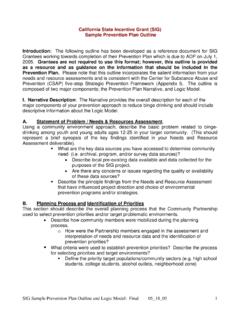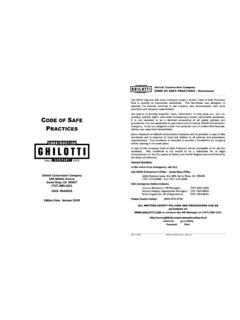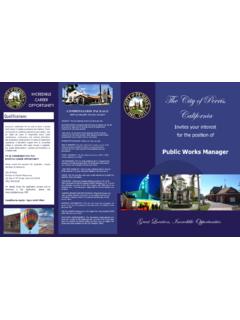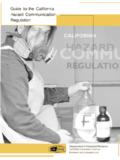Transcription of POLICY BRIEFING 01 - ca-cpi.org
1 POLICY BRIEFING 01. Model Social Host Liability Ordinance WITH LEGAL COMMENTARY AND RESOURCES. SEPTEMBER 2005. A Publication of the training , Applied Research, and Alcohol and Drug Prevention Division Ventura County Behavioral Health Department Ventura County Behavioral Health The intent of this report is to provide useful information to municipal governments, private institutions and community coalitions who are formulating responses to the many problems caused by home parties involving underage drinking. Using this Publication This is public information and is meant to be shared. Copy and distribute this POLICY Brie ng as appropriate. For additional copies please visit For more information, contact: Ventura County Behavioral Health Department training , Applied Research, and Alcohol and Drug Prevention Division Kathleen Staples, Division Manager Daniel Hicks, Program Administrator Center for the Study of Law and Enforcement POLICY Paci c Institute for Research and Evaluation Stacy Saetta, , Legal POLICY Researcher or visit Suggested citation: Model Social Host Liability Ordinance with Legal Commentary, Center for the Study of Law and Enforcement POLICY , Paci c Institute for Research and Evaluation (Ventura, CA: Ventura County Behavioral Health Department Publication, 2005).
2 Design: Idea Engineering Model Social Host Liability Ordinance WITH LEGAL COMMENTARY AND RESOURCES. SEPTEMBER 2005. A Publication of the training , Applied Research, and Alcohol and Drug Prevention Division Ventura County Behavioral Health Department Center for the Study of Law and Enforcement POLICY Pacific Institute for Research and Evaluation Ventura County Behavioral Health 1. Table of Contents INTRODUCTION .. 2. THE SOCIAL AND LEGAL CONTEXT.. 3. HIGHLIGHTS .. 7. MODEL SOCIAL HOST LIABILITY ORDINANCE .. 8. Section 1: Short Title .. 8. Section 2: Legislative Findings .. 8. Section 3: Purposes .. 9. Section 4: De nitions .. 9. Section 5: Responsibility for Proper Property Management .. 10. Section 6: Penalties for Violation of Ordinance .. 10. Section 7: Recovery of Response Costs .. 11. Section 8: Billing and Collection .. 12. Section 9: Reservation of Legal Options .. 13. Section 10: Appeal .. 13. Section 11: Severability .. 13. Section 12: Effective Date.
3 13. BIBLIOGRAPHY.. 14. APPENDIX .. 15. Relevant California State Statutes .. 15. Sample California Ordinances .. 16. Useful Websites .. 22. Center for the Study of Law and Enforcement POLICY 2 Ventura County Behavioral Health Pacific Institute for Research and Evaluation Introduction This is the third in a series of reports associated with Ventura County Limits, a Community Partnership for Responsible Alcohol Policies and Practices. Two previous reports considered issues related to underage and binge drinking in Ventura County, and the circumstances of drinking for young adults in Ventura County prior to their arrest for impaired driving (please see ). Both of these publi- cations suggested that home parties are settings in Ventura County where excessive alcohol consumption among underage and young adult drinkers can lead to dangerous even deadly consequences, and pointed to the need for new community prevention tools. Nearly three in ten ( ) of those 25 and younger that binge drink report last doing so in their own homes, and report last binge drinking at someone else's home.
4 These data point to house parties as settings for binge drinking among young adults.. Underage and Binge Drinking: Selected Findings from a Telephone Survey of Ventura County Residents (2005). As part of its county-wide initiative to reduce underage and dangerous drinking, including the serious and persistent problems associated with home drinking parties, the Ventura County Behavioral Health Department, in collaboration with the Center for the Study of Law Enforcement and POLICY (CSLEP) of the Paci c Institute for Research and Evaluation (PIRE), has developed this publication to aid local governments and other community agencies in the formulation of effective prevention policies. The model ordinance and commentary were designed to address communities of diverse settings and needs. They also take into consideration various concerns of municipalities with respect to effectively deterring loud, unruly or dangerous parties in private settings, using clear explanations of the different types of Social Host Liability and presenting options for imposing fees and recovering costs associated with law enforcement, re, or other emergency response services.
5 In developing this publication the authors and sponsors have been encouraged by the intense concern of par- ents, community coalitions, law enforcement personnel and elected of cials, all of whom have been calling out for better strategies to reduce the many social, health and public safety consequences of underage drink- ing parties. We hope the words on the following pages lead to community action, and, in turn, new social realities, that improve the quality of life and sense of safety for everyone in Ventura County. Center for the Study of Law and Enforcement POLICY Pacific Institute for Research and Evaluation Ventura County Behavioral Health 3. The Social and Legal Context The National Academies Institute of Medicine's seminal report entitled Reducing Underage Drinking: a Collective Responsibility, released in 2003, documents the wide ranging and devastating consequences of adolescent and young adult consumption of alcoholic beverages.
6 Estimating the annual social cost of underage drinking to be at least $53 billion, Reducing Underage Drinking urges states and localities to enact a comprehensive set of strategies to reduce underage alcohol consumption. These strategies include strengthening social host liability laws to deter underage drinking parties and other gatherings. Social host liability refers to laws that hold non-commercial individuals responsible for underage drinking events on property they own, lease, or otherwise control. Whereas laws prohibiting furnishing alcoholic beverages to underage persons target providing alcoholic beverages to underage persons, social host laws target providing the venue where underage drinking takes place. A Practical Guide to Preventing and Dispersing Underage Drinking Parties (PIRE, undated) articulates why regulating underage drinking parties and other gatherings is an important priority and why social host liability laws should be considered an essential law enforcement strategy for deterring these gatherings: Many people dismiss underage drinking as a normal rite of passage in adolescence.
7 However, it is important to remember that alcohol is one of the most common contributors to injury, death, and criminal behavior among youth (US Department of Health And Human Services, 1992). Underage alcohol use can have immediate and potentially tragic consequences as well as long-range harmful consequences, such as increased risk for chronic alcohol addiction (Grant and Dawson, 1997). Enforcement activities to limit youth access to alcohol are critical to reducing underage drinking and its often tragic consequences.. One common way that underage drinkers gain access to alcohol is at parties. These parties are commonly large gatherings of young people in a home .., in an outdoor area (like a beach or a park), or in some other venue (like a warehouse rented for the purpose). These parties can be particularly problematic because of the number of drinkers involved in the large quantities of alcohol consumed. Reports of alcohol poisonings, traf c crashes, property damage, community disturbance, violence, and sexual assault are all too common as a result of these parties.
8 Teen parties are a primary avenue for underage drinking for high school and college students and of high consumption of alcohol and binge drinking. Mayer, Forster, Murray, and Wagenaar (1998). found that the most common setting for drinking among high school seniors was someone else's home. High consumption ( ve or more drinks) is also associated with drinking in larger groups. The Center for the Study of Law and Enforcement POLICY 4 Ventura County Behavioral Health Pacific Institute for Research and Evaluation authors conclude that interventions that modify the environments in which adolescents nd themselves have an impact on alcohol consumption levels. Policies aimed at increasing the liability of adults who provide alcohol to or drink with minors may help to reduce underage drinking. (Mayer et al: 214). Approximately 46,200 of Ventura County residents are in high school grades nine through twelve1, living in widely different residential, rural farming, canyon, beach, and coastal communities.
9 Communities, regardless of type, report that many parents have a high tolerance for teen parties, allowing them to occur on their property often without any Regulatory Strategies for Preventing Youth Access to Alcohol: Best Practices (PIRE, 1999) observes: This tolerance apparently stems from three misconceptions or beliefs: (1). alcohol, particularly beer, is a relatively harmless drug compared to illegal drugs, and its consumption is part of the passage to adulthood; (2) permitting consumption in a residential setting is safer than having it occur in open areas, where there is a higher risk of problems; and (3) teen drinking is inevitable, and it is safer if it occurs in a controlled, residential setting.. Ventura County has three community colleges in Moorpark, Oxnard, and Ventura; a new four-year university Cal State Channel Islands in the Camarillo area; and California Lutheran University, a private institution in Thousand Oaks. Clapp, Shillington, and Segars (2000) found that for college students, parties were among the most common occasions for socializing and were the settings most associated with heavy drinking.
10 Similarly, Jones-Webb, Toomey, Miner, Wagenaar, Wolfson, and Poon (1997) found that a common source of alcohol for college drinkers was parties-- including house parties, outdoor parties, or fraternity parties. Respondents to youth focus groups saw little risk of law enforcement intervention at underage drinking parties, indicating that expectations about enforcement of underage drinking laws were low. Community tolerance is compounded by the legal obstacles to law enforcement agencies in deterring teen parties and college gatherings. (PIRE, 1999: 27.) California law prohibits both furnishing alcohol to underage persons and youth possession on public property. On the other hand, state law does not prohibit youth possession on private property, and state law does not prohibit youth consumption anywhere. Law enforcement detecting an underage party may not have legal grounds to enter the premises, be unable to con scate the alcohol, trace its original purchaser, or hold the adult homeowner, landlord, or renter responsible for allowing the party on the premises.






